inflation pressure AUDI Q7 2014 Owner´s Manual
[x] Cancel search | Manufacturer: AUDI, Model Year: 2014, Model line: Q7, Model: AUDI Q7 2014Pages: 340, PDF Size: 85.02 MB
Page 276 of 340

274 T ire s and wheel s
-Never mount used tires on yo ur vehicle if
you are not sure of their "previous histo
ry." Old used tires may have been dam
aged even though the damage cannot be
seen that can lead to sudden t ire failure
and loss of vehicle control.
- If you notice unusual vibration or if the
vehicle pulls to one side when driving, al
ways stop as soon as it is safe to do so
and check the wheels and tires for dam
age.
(D Note
Please note that summer and winter tires
are designed for the cond itions that are
Glossary of tire and loading terminology
Accessory weight
means t he comb ined we ight (in excess of
those sta ndard items which may be rep laced)
of au toma tic tra nsmission, power steer ing,
power brakes, power windows, power seats,
radio, and heater, to the extent that th ese
items are availab le as factory -installed equip
ment (whether installed or not) .
Aspect ratio
means t he ratio of the he ight to the w idth of
the tire in percent . Numbers of 55 or lower in
dicate a low sidewall for improved steering re
sponse and better overall handling on dry pavement .
Bead
means the part of the ti re that is made of
steel wires, wrapped or reinforced by ply cords
and that is shaped to fit the rim.
Bead separation
means a b reakdown of the bond between
components in the bead.
Cord
means the strands forming the plies in the
tire . typ
ica l in those seasons . Audi recommends
using winter tires during the winter
months . Low temperatures signif icant ly
decrease the e lasticity of summer tires,
which affects tract ion and brak ing ability.
If summer tires are used in very co ld tem
peratures, cracks ca n form on the tread
bars, res ulting in permanent tire damage
that can cause loud driving no ise and un
balan ced t ires. Audi is not responsible for
th is type of damage .
Cold tire inflation pressure
means the tire p ressu re recommended by t he
vehicle manufacturer fo r a tire of a des igna ted
s iz e that has not bee n driven for more than a
coup le of miles (k ilometers) at low speeds in
t h e three hour period before the tire pressure
is measured or adjusted.
Curb weight
mea ns the we ight of a motor ve hicl e w ith
standard equipment including the max imum
capacity of fuel, oil, and coolant, air condi
tioning and additional weight of optiona l
equipment.
Extra load tire
me ans a t ire design to operate at higher loads
and at h igher inflation pressures than the cor
responding standard tire . Extra load tires may
be identified as "XL", "x l" , "EXTRA LOAD", or
"RF" on the sidewall.
Gross A xle Weight Rating ("GAWR ")
means the lo ad -c a rry ing c apac ity of a s ingle
axle system , measured a t the tire-ground in
terfaces.
Gross Vehicle Weight Rating ("GVWR ")
mea ns the maximum total loaded we ight of
t h e ve hicl e. .,.
Page 277 of 340

Groove
means the space between two adjacent tread
ribs.
Load rating (code)
means the maximum load that a tire is rated
to carry for a given inflation pressure. You
may not find this information on all tires be
cause it is no t req uired by law.
Maximum load rating
means the load rating for a t ire at the max i
mum permissible inflation pressure for that
tire.
Maximum loaded vehicle weight
means the sum of:
(a) Curb weight
(b) Accessory weight
(c) Vehicle capacity weight, and
(d) Production options weight
Maximum (permissible) inflation pressure
means the maximum cold inflation pressure
to which a tire may be inflated. Also called "maximum inflation pressure."
Normal occupant weight
means 150 lbs. (68 kilograms) times the
number of occupants seated in the vehicle up
to the total seating capacity of your vehicle.
Occupant distribution
means distribution of occupants in a vehicle.
Outer diameter
means the overa ll diamete r of an inflated new
tire.
Overall width
means the linear distance between the exteri
ors of the sidewalls of an inflated tire, includ
in g elevations due to labeling, decorations, or
protective bands or ribs.
Ply
means a layer of rubber-coated parallel cords.
Tires and wheels 275
Production options weight
means the combined weight of those installed
regular production options we ighing over 5
lbs. (2.3 kg) in excess of those standard items
which they replace, not previously considered
in curb weight or accessory weight, including
heavy duty brakes, ride levelers, roof rack,
heavy duty battery, and spec ial tr im .
Radial ply tire
means a pneumatic tire in which the ply cords
that extend to the beads are laid at substan
tia lly 90 degrees to the center line of the
tread .
Recommended inflation pressure
see ¢ page 2 7 4, Cold tire inflation pressure.
Reinforced tire
means a t ire design to operate at higher loads
and at h igher inflation pressures than the cor
re sp onding standard tire. Reinforced tires
may be identified as "XL", "xl", "EXTRA LOAD",
or "RF" on the sidewa ll.
Rim
means a metal support for a tire or a t ire and
tube assembly upon which the tire beads are
seated.
Rim diameter
means nom inal diameter of the bead seat. If
you change your wheel s ize, you will have to
purchase new tires to match the new rim di
ameter.
Rim size designation
means r im diameter and width .
Rim width
means nominal distance between rim flanges .
Sidewall
means that portion of a tire between the
tread and bead.
•
•
Page 279 of 340
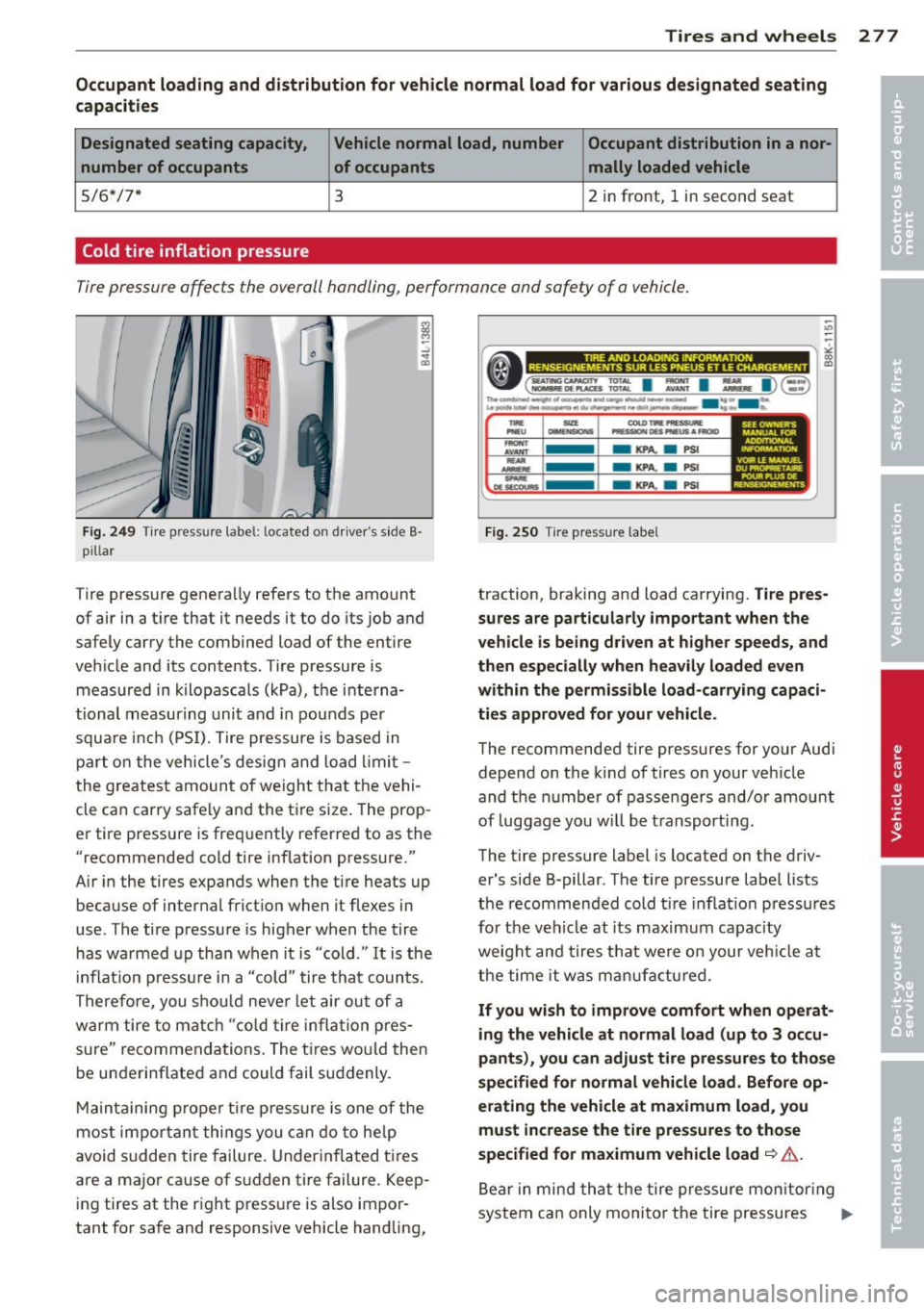
Tires and wheels 277
Occupant loading and distribution for vehicle normal load fo r various d esignated seat ing
capaci tie s
Designated seating capacity , Vehicle normal load , number Occupant distribution in a nor-
number of occupants of occupants mally loaded vehicle
5/6*/7" 3 2 in front, 1 in second seat
Cold tire inflation pressure
Tire pressure affects the overall handling, performance and safety of a vehicle.
I
JJ
0
Fig. 249 Tire pressure labe l: located on driver 's s ide B·
p ill ar
Tire pressure genera lly refers to the amount
of air in a tire that it needs it to do its job and
safely carry the combined load of the entire
vehicle and its contents . Tire pressure is
measured in kilopasca ls (kPa), the i nte rna
tional measur ing unit and in pounds pe r
squa re i nch (PSI). Tire pressure is based in
part on the vehicle 's design and load limi t -
the greatest amount of weight that the vehi cle can carry safe ly and the t ire size . The prop
er tire pressure is frequent ly referred to as the
"recommended cold tire inflation pressure."
A ir in the tires expands when the tire heats up
because of internal friction when it flexes in
use . The tire p ressu re is higher when the tire
has warmed up than when it is "cold ."
It is the
i nflat ion p ressure i n a "cold " tire that counts.
Therefo re, you shou ld neve r let air out of a
warm tire to ma tch "cold tire infla tion pres
sure" recommendations. The t ires wo uld then
be underinflated and could fail suddenly .
M aintaining p roper t ire press ure is one of the
most impor tant things you can do to he lp
avoid sudden tire failure. Underinflated t ires
are a ma jo r cause of s udden tire failure . Keep·
ing tires at the right pressure is also impor
tant for safe and responsive vehicle handling,
-tD
-
---------------------.. ,;
•(==.: I :::; I :,,. I)@ gi n. ............ .,_____, .... -.ito._.. ____ .... _ ...
&..p0idit,101111-~--.,...,....-- ..... ~ .... ..
-··-.....
-
-Dlst<:OURS
- KPA.. a PSI
- KPA..
a PS I
- KPA.. a PSI
Fig. 2 50 Tire pressu re labe l
traction, braking and load carrying. Tire p res
sures are particularly importa nt when the
vehicle is being dr iven at higher speeds, and
th en e spe cially when heav ily load ed even
with in the permissible load-carrying capaci
ties approved for your veh icle.
The recommended tire pressures for your Audi
depend on the kind of tires on your ve hicle
and the n umbe r of passengers and/o r amount
of luggage you w ill be transporti ng.
The tire pressure label is located on the driv
er's side B -pillar . The tire pressure labe l lists
the recommended cold t ire inflat io n pressures
for t he vehicle at its maxi mum capac ity
weight and tires that were on your veh icle at
t he time it was m anufactu red.
If you wish to improve comfort wh en operat
ing the vehicle at normal load (up to 3 occu
pant s), you can adju st tire press ures to those
spe cified for n ormal vehi cle load . Before op
erating the vehicle at maximum load , you
must increase the tire pre ssure s to those
specified for ma ximum vehicle load
¢ & .
Bear in mind that the tire pressure mon itor ing
system can only monitor the tire pressures
II>
Page 280 of 340
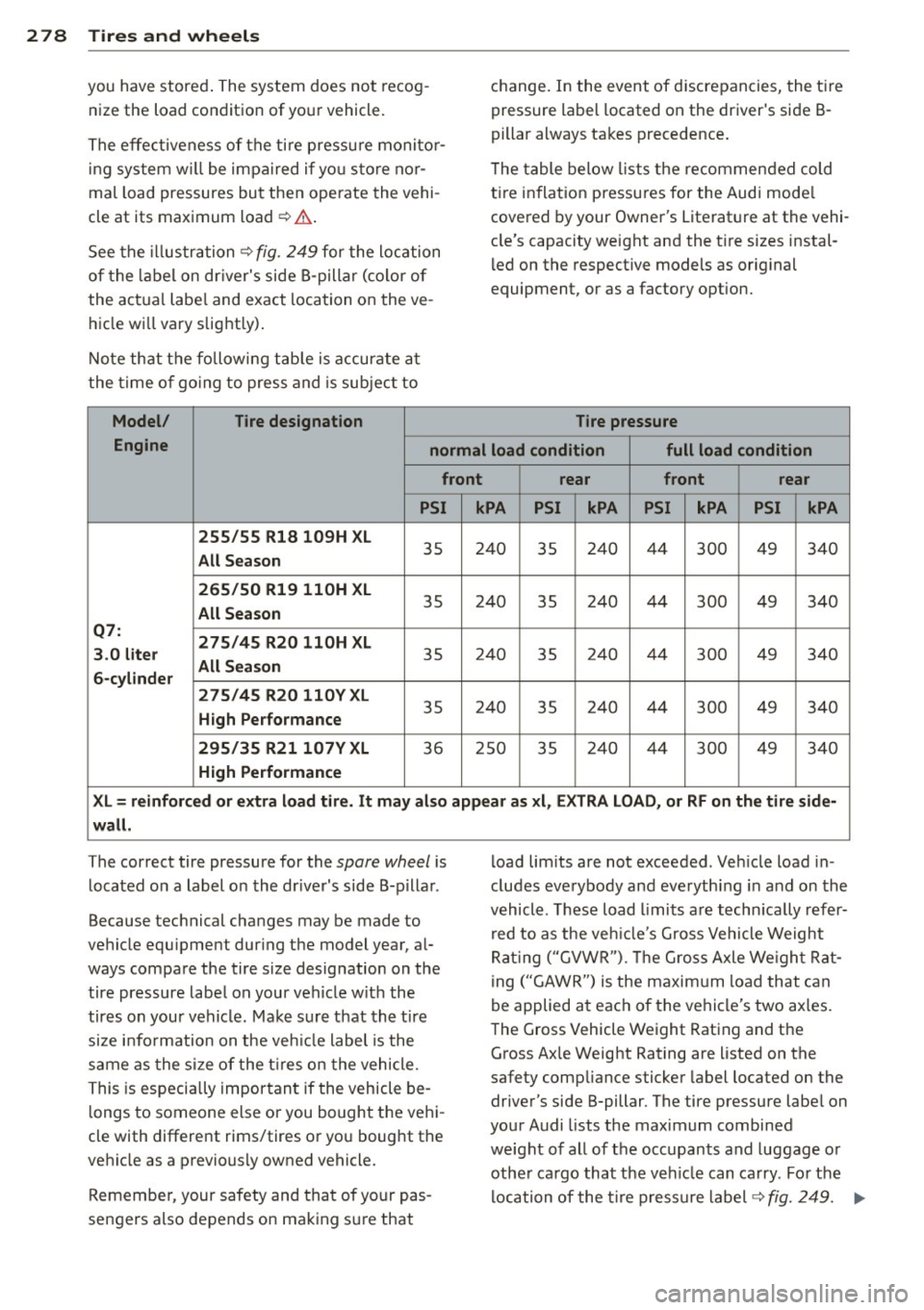
278 Tires and wheels
you have stored. The system does not recog
nize the load condition of your vehicle.
The effectiveness of the tire pressure monitor
ing system w ill be impaired if yo u store nor
mal load pressures but then operate the vehi
cle at its maximum load¢.&. .
See the illustration¢
fig. 249 for the location
of the label on driver's side 8-pillar (color of
the actua l label and exact location on the ve
hicle wi ll vary slightly).
Note that the following table is accurate at
the time of going to press and is subject to
Model/ Tire designation
change. In the event of discrepancies, the tir e
pressure label located on the driver's side 8-
pillar always takes precedence.
T he table below lists the recommended cold
ti re inflation pressures for the Audi mode l
covered by your Owner's Literature at the vehi
cle's capacity weight and the t ire sizes instal
l ed on the respective models as original
equipment, or as a factory option.
Tire pressure
Engine normal load condition full load condition
front rear
front rear
PSI kPA PSI kPA PSI kPA PSI kPA
255/55 Rl8 109H XL
35 240 35 240 44
300 49 340 All Season
265/50 Rl9 llOH XL
35 240
35 240
44
300 49 340 All Season
Q7: 275/45 R20 llOH XL
3 .0 liter
35 240
35 240 44
300 49 340 All Season
6-cylinder
275/45 R20 llOYXL
35 240 35 240 44 300 49 340 High Performance
295/35 R21 107V XL
36 250 35 240 44 300 49 340
High Performance
XL= reinforced or extra load tire. It may also appear as xl, EXTRA LOAD, or RF on the tire side-
wall.
The correct tire pressure for the spare wheel is
located on a label on the driver's side 8-p illar .
Because technical changes may be made to
vehicle equipment dur ing the model year, al
ways compare the tire size designation on the
tire pressure label on your vehicle w ith the
tires on your vehicle. Make sure that the tire
size info rmation on the vehicle label is the
same as the size of the tires on the vehicle.
This is especially important if the vehicle be
l ongs to someone else or you bought the vehi
cle with different rims/tires or you bought the
vehicle as a previously owned vehicle.
Remember, your safety and that of yo ur pas
sengers also depends on making s ure that load
limits are not exceeded . Veh icle load in
cludes everybody and eve ryth ing in and on the
vehicle. These load limits are techn ica lly refer
red to as the veh icle's Gross Vehicle Weight
Rating ("GVWR"). The Gross Axle We ight Rat
ing ("GAWR") is the maximum load that can
be applied at each of the vehicle's two ax les.
The Gross Vehicle Weight Rating and the Gross Axle Weight Rating are listed on the
safety comp liance sticker label located on the
driver's side 8-pillar . The tire pressure label on
your Audi lists the maximum combined
weight of all of the occupants and luggage or
other cargo that the veh icle can carry . For the
location of the tire pressure label¢
fig. 249. ..,_
Page 281 of 340
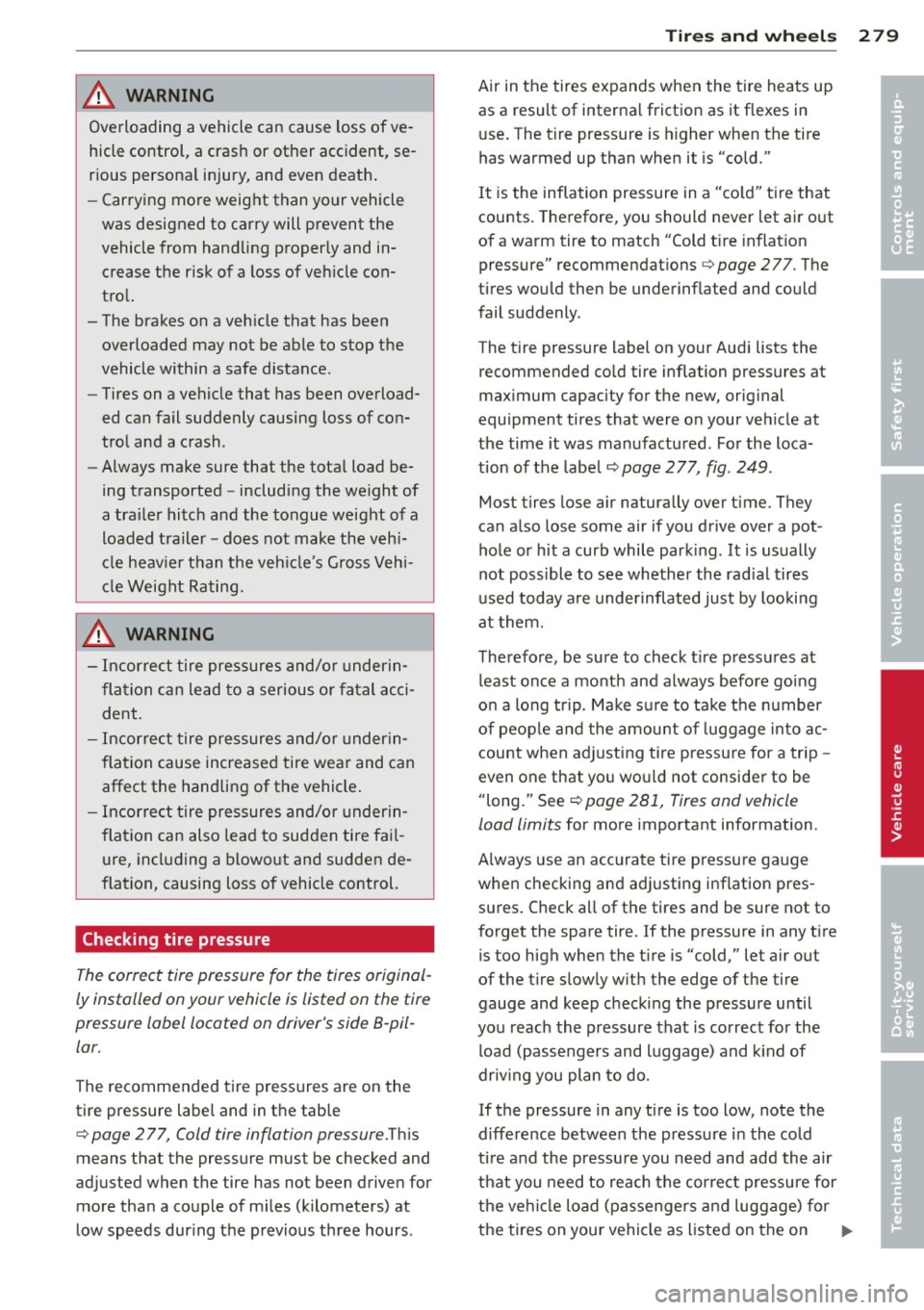
& WARNING
Overloading a vehicle can cause loss of ve
hicle control, a crash or other accident, se
rious personal injury, and even death .
- Carrying more weight than yo ur vehicle
was designed to carry will prevent the
vehicle from handling properly and in crease the risk of a loss of veh icle con
trol.
- The brakes on a veh icle that has been
overloaded may not be able to stop the
vehicle within a safe distance .
- Tires on a vehicle that has been overload
ed can fail suddenly causing loss of con
tro l and a crash .
- Always make sure that the tota l load be
ing transported -including the we ight of
a tra ile r hi tch and the tongue weight of a
loaded trailer -does not make the veh i
cle heav ier than the veh icle's Gross Vehi
cl e Weight Rating.
& WARNING
- Incorre ct tire pressures and/or underin
fla tion can lead to a serious o r fatal acci
dent.
- Incorrect tire pressures and/or underin
flation cause increased tire wear and can
affect the handling of the vehicle .
- Incorre ct tire pressures and/or underin
fla tion can also lead to sudden tire fa il
ure, incl uding a blowo ut and sudden de
flation, causing loss of vehicle control.
Checking tire pressure
-
The correct tire pressure for the tires original
ly installed on your vehicle is listed on the tire
pressure label located on driver's side 8-pil lar.
The recommended tire pressures are on the
tire pressure label and in the tab le
c:::> page 277, Cold tire inflation pressure .Th is
means that the pressure must be checked and
adjusted when the tire has not been driven for more than a couple of m iles (kilometers) at
low speeds during the p revious three hours .
Tires an d wheel s 2 79
Air in the tires expands when the tire heats up
as a result of internal friction as it flexes in
u se . The tire pressure is h igher when the tire
has warmed up than when it is "cold."
It is the inflation pressure in a "co ld" t ire that
counts . The refore, you should never let air o ut
of a warm tire to match "Cold t ire in flat ion
pressure" recommendat ions ¢
page 277 . The
tires wo uld then be underinf lated and could
fail suddenly .
The t ire pressure label on your Audi lists the
recommended co ld tire inflation pressures at
maximum capacity for the new, orig inal
equipment tires that were on your ve hicle at
the time it was ma nufactured . For the loca
tion of the labe l
¢page 277, fig . 249 .
Most tires lose air naturally over t ime . They
can a lso lose some air if you drive over a pot
hole or hit a curb while park ing.
It is usually
not poss ible to see whethe r the rad ia l tires
u sed today are under inflated just by loo kin g
at them.
T herefo re, be su re to check t ire pressu res at
l east once a mo nth and a lways befo re go ing
o n a long tr ip. Ma ke s ure to ta ke t he number
of peop le and the amount of luggage in to ac
count when ad justing tire pressu re for a trip -
even one that yo u wo uld not conside r to be
"long." See¢
page 281, Tires and vehicle
load limits
for more important information .
A lways use an acc ura te tire pressu re ga uge
when checking and adj usting inf lation pres
s ur es . Check a ll of the tires and be sure not to
forget the spare tire. If the pressure in any t ire
is too high when the tire is "cold," let a ir o ut
of the t ire s low ly w ith the edge of the tire
gauge and keep checking the pressure until
yo u reach the pressure that is correct for the
load (passengers and luggage) and k ind of
driv ing you plan to do.
If the pressure in any tire is too low, note the
difference between the pressure i n the cold
t ir e and the pressu re you need and add the air
t h at you need to reach the cor re ct pressure for
the ve hicle load (passengers and luggage) for
the tires on your vehi cle as listed on the on •
•
Page 284 of 340
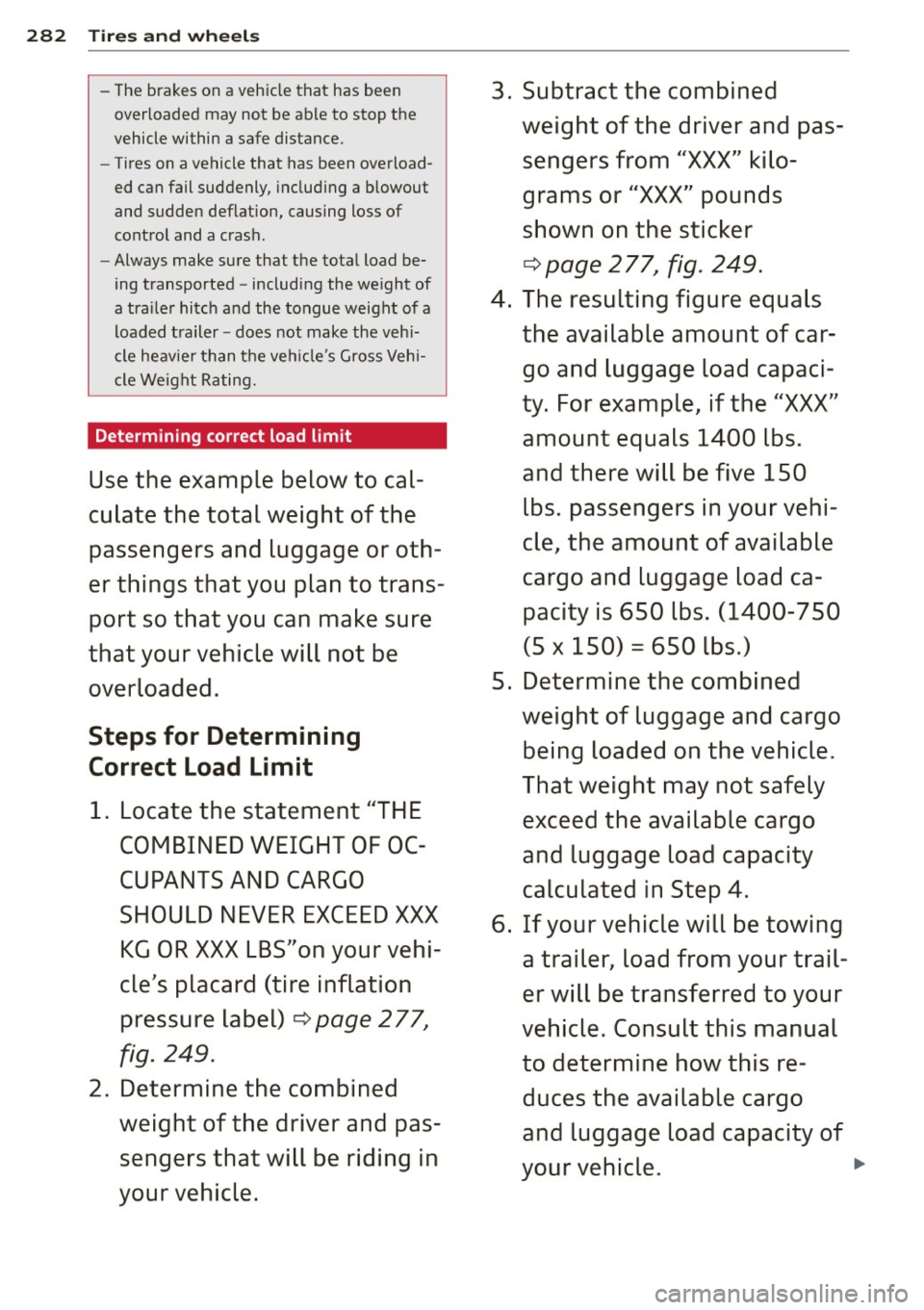
282 Tires and wheels
-The brakes on a vehicle that has been
overloaded may not be able to stop the
vehicle within a safe distance.
- Tires on a vehicle that has been overload
ed can fail suddenly, including a blowout
and sudden deflation, causing loss of
control and a crash.
- Always make sure that the total load be
ing transported -including the weight of
a trailer hitch and the tongue weight of a
loaded trailer -does not make the vehi
cle heavier than the vehicle's Gross Vehi
cle Weight Rating.
Determining correct load limit
Use the example below to cal
culate the total weight of the
passengers and luggage or oth
er things that you plan to trans
port so that you can make sure
that your vehicle will not be overloaded.
Steps for Determining
Correct Load Limit
1. Locate the statement "THE COMBINED WEIGHT OF OC
CUPANTS AND CARGO
SHOULD NEVER EXCEED XXX KG OR XXX LBS"on your vehi
cle's placard (tire inflation pressure label)
¢ page 2 77,
fig. 249.
2. Determine the combined
weight of the driver and pas
sengers that will be riding in
your vehicle. 3
. Subtract the combined
weight of the driver and pas sengers from
"XXX" kilo
grams or
"XXX" pounds
shown on the sticker
¢page 277, fig. 249.
4. The resulting figure equals the available amount of car
go and luggage load capaci
ty. For example, if the
"XXX"
amount equals 1400 lbs.
and there will be five
150
lbs. passengers in your vehi
cle, the amount of available
cargo and luggage load ca
pacity is
650 lbs. (1400-7 50
(5 X 150) = 650 lbs.)
5. Determine the combined
weight of luggage and cargo
being loaded on the vehicle.
That weight may not safely
exceed the available cargo
and luggage load capacity
calculated in Step 4.
6. If your vehicle will be towing
a trailer, load from your trail
er will be transferred to your
vehicle. Consult this manual
to determine how this re duces the available cargo
and luggage load capacity of
your vehicle. ..,
Page 288 of 340
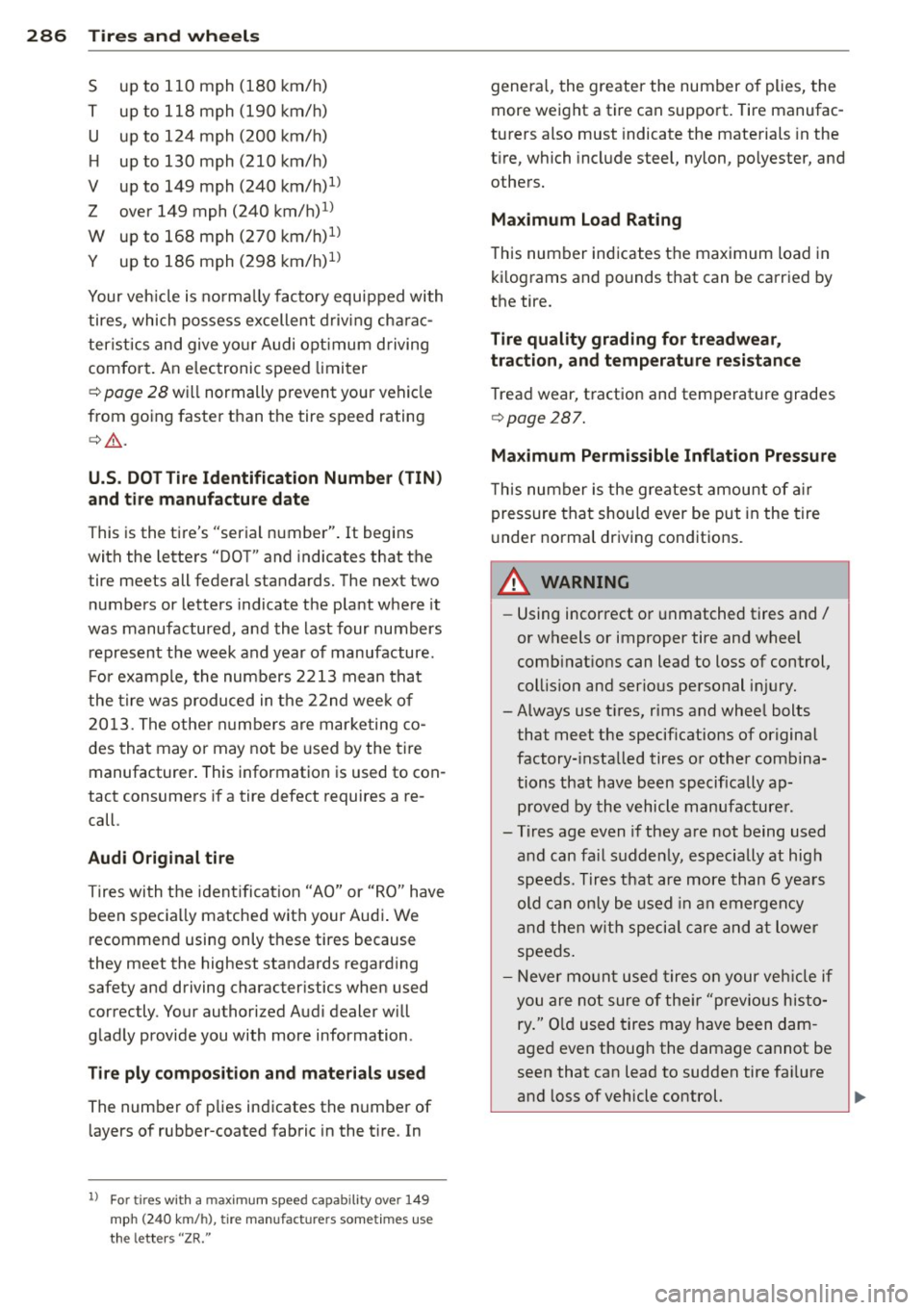
286 Tires and wheels
S up to 110 mph (180 km/h)
T up to 118 mph (190 km/h)
U up to 124 mph (200 km/h)
H up to 130 mph (210 km/h)
V up to 149 mph (240 km/h)1l
Z over 149 mph (240 km/h)ll
W up to 168 mph (270 km/h)ll
Y up to 186 mph (298 km/h)
1
l
Your veh icle is normally factory equipped with
tires, which possess excellent driving charac
teristics and give yo ur Audi opt imum d riving
comfort . An electronic speed limiter
c::> page 28 will normally prevent your vehicle
from going faster than the tire speed rating
¢ &. .
U.S. DOT Tire Identification Number (TIN)
and tire manufacture date
This is the tire's "serial number". It begins
with the letters "DOT" and indicates that the
tire meets all federal standards. The next two
numbers or letters indicate the plant where it
was manufactured, and the last four numbers
represent the week and year of manufacture.
For example, the numbers 2213 mean that
the tire was produced in the 22nd wee k of
2013. The other numbers are mar keting co
des that may or may not be used by the tire
manufacturer . This information is used to con
tact consumers if a tire defect requires a re
call.
Audi Original tire
Tires with the identification "AO" or "RO" have
been specia lly matched with your Audi . We
recommend using only these tires because
they meet the highest standards regard ing
safety and driving character istics when used
correctly. Your authorized Audi dealer will
gladly provide you with more information.
Tire ply composit ion and materials used
The number of plies indicates the number of
l ayers of rubber-coated fabric in the tire. In
ll For tir es w it h a m ax im um spee d ca pabil ity ove r 149
mph (2 40 km/ h), ti re manufact urers somet imes use
the lett ers " ZR."
genera l, the greater the number of plies, the
more weight a tire can support. Tire manufac
turers also must indicate the materials in the
t ir e, which include steel, nylon, po lyester, and
others.
Maximum Load Rating
This number ind icates the maximum load in
kilograms and pounds that can be carried by
the tire.
Tire quality grading for treadwear,
traction , and temperature resistance
Tread wear, traction and temperature grades
c::> page
287.
Maximum Permissible Inflation Pressure
Th is number is the greatest amount of air
pressure that should ever be put in the tire
u nder normal driving conditions.
.&, WARNING ~ -
-Using incorrect or unmatched tires and/
or wheels or improper tire and wheel
comb inat ions can lead to loss of control,
coll is ion and serious personal injury.
-Always use t ires, rims and whee l bolts
that meet the specifications of original
factory- installed tires or other combina
tions that have been specifically ap
proved by the vehicle manufacturer.
- Tires age even if they are not being used
and can fail suddenly, especially at high
speeds. Tires that are more than 6 years
old can only be used in an emergen cy
and then with special care and at lower
speeds.
- Never mount used tires on your vehicle if
you are not sure of their "previous histo
ry." Old used tires may have been dam
aged even though the damage cannot be
seen that can lead to sudden tire fa ilure
and loss of vehicle control.
Page 292 of 340

29 0 T ire s and wheel s
driving a few yards and correct if neces
sary. Follow the instructions from the
snow cha in manufacturer when doing so .
- If the Adaptive Air Suspension* should
malfunction, do not mount or use snow
chains because the vehicle will be ex
tremely low. If you do dr ive with snow
chains on while the vehicle is at this lev
el, the snow chains might severely dam
age the wheelhouse and other parts of
the veh icle.
(!) Tips
Where snow cha ins are mandatory oncer
tain roads, this normally also applies to
veh icles with all-whee l dr ive.
Wheel bolts
Wheel bolts must always be tightened to the
correct torque .
The design of wheel bolts is matched to the
factory installed r ims. If different rims are fit
ted, the correct wheel bolts with the r ight
l ength and correctly shaped bolt heads must
be used. This ensures t hat wheels a re fitted
secure ly and that the brake system f unctions
correctly .
I n ce rtain circumstances, you may not use
wheel bolts from a different vehicle -even if it
is the same mode l
<=?page 318.
.&_ WARNING
Improperly tightened o r maintained wheel
bolts can become loose ca using loss of
contro l, a co llision and serious persona l in
jury.
- Always keep the wheel bolts and the
threads in the wheel hubs clean so the
wheel bolts can turn easily and be prop
erly t ightened.
- Never grease or oil the wheel bo lts and
the threads in the wheel hubs. They can
become loose w hile driving if greased or
oiled, even if tightened to the specified
torque. -
On ly use wheel bolts that be long to the
rim being installed .
- Never use different wheels bolts on yo ur
veh icle.
- Always maintain the correct tightening
torque for the whee l bolts to reduce the
risk of a whee l loss. If the tightening tor
que of the wheel bolts is too low, they
can loosen and come out when the vehi
cle is mov ing. If the tightening torque is
too high, the wheel bolts a nd threads
can be damaged and the whee l can be
come loose.
(D Note
The specified torque for the wheel bolts is 120 ft lb ( 160 Nm) with a to le rance of
± 7,4 ft lb( ± 10 Nm) . T orque wheel bolts
diagonally. After changi ng a wheel, the
torque m ust be che cked as soon as possi
ble with a to rque wrenc h - preferab ly by an
a uthorized Audi dea le r or q ualified work
shop.
Low aspect ratio tires
Your Audi is factory-equipped w ith low aspect
ratio tires. These tires have been tho roughly
tested and been se lected specifically for your
model for their superb performance, road fee l
and hand ling under a variety of d riving condi
tions . As k your au thor ized A udi dealer for
more de tails .
T he low aspect ratio of these t ires is ind icated
by a numera l of
55 or l ess in the tire's s ize
designation. The n umeral rep resen ts the ratio
of the tire's s idewa ll height in relation to its
tread width exp ressed in percentage . Conven
t iona l tires have a he ight/width ratio of 60 or
more.
The performan ce of l ow-a spect-r atio tire s is
particularl y sen sitive to imp roper inflation
pre ssure. It is therefo re important that low
a spect ratio tires are inflated to the specified
pressure and th at the inflation pressure is
regularly checked and mainta ined. Tire pres -
s u res should be checked at least onc e a ..,.
Page 293 of 340

month and always before a long trip
¢ page 2 79, Checking tire pressure.
What you can do to avoid tire and rim
damage
L ow aspect ratio tires can be damaged more
easi ly by impact with potho les, curbs, gu llies
or ridges on the road, particularly if the tire is
underinflated.
I n order to minimize the occurrence o f impact
damage to the tires of your vehicle, we recom
mend that you observe the following precau
tions :
- Always maintain recommended inflation
pressures. Check your tire pressure every
2,000 miles (3,000 km) and add air if neces
sary.
- Drive carefully on roads with potholes, deep
gullies or ridges. The impact from driving
through or over such obstacles can damage
your tires. Impact with a curb may also cause damage to your tires.
- After any impact, immediately inspect your
t ires or have them inspected by the nearest
authorized Aud i dealer . Replace a damaged
t ir e as soon as possible .
- Inspect your t ires every 2,000 miles (3,000
km) for damage and wear . Damage is not al
ways easy to see. Damage can lead to loss of
air and unde rinflation, wh ich could eventu
ally cause tire failure. If you be lieve that a
tire may have been damaged, replace the
tire as soon as possible.
- These tires may wea r more quickly than oth
ers.
- Please also remember that, while these tires
deliver responsive handling, they may ride
less comfortably and make more noise than
other choices .
Reduced performance in winter/cold
season conditions
All tires are designed for certain purposes .
The low aspect ratio, ultra high performance
tires originally installed on your veh icle are in
tended for max imum dry and wet road per
formance and handling . They are not suitable
for cold, snowy or icy weather condit ions . If
Tires and wheels 2 91
you drive under those ci rcumstances, you
shou ld equip your vehicle with all-season or
winter tires, which offer better traction under
those conditions. We suggest you use the rec ommended snow or all-season t ires specified
for your vehicle, or their equivalent .
Refer to
¢ page 288 for more detailed infor
mation regarding winter tires .
Tire pressure
monitoring system
ill General notes
Each tire, incl uding the spare (if provided),
shou ld be checked monthly when co ld and in
flated to the inflation pressure recommended by the veh icle manufacturer on the veh icle
placard or tire inflation pressure label. (If your
vehicle has tires of a d ifferent size than the
s iz e indicated o n the vehicle placard or tire in
flat io n pressu re lab el, you sho uld determine
the p roper tire inflation pressure for those
tires).
As an added safe ty feature, your veh icle has
been equipped with a tire pressure monito ring
system ( TPMS) that illuminates a low ti re
pressure telltale when one or more of your
tires is significantly under-inflated. According
l y, when the low tire pressure te lltale illumi
nates, you should stop and check your tires as
soon as possible, and inflate them to the
proper pressure . Driving on a sign ificantly un
der- inflated t ire causes the tire to overheat
and can lead to tire fa ilure. Under-inflation al
so reduces fuel efficien cy and tire tread life,
and may affect the vehicle's hand ling and
stopping ability .
Please note that the TPMS is not a subst itute
for proper tire maintenance, and it is the driv
er's responsibility to maintain correct tire
pressure, even if under-inflation has not
reached the leve l to tr igger illumination of the
T PMS low tire pressure tellta le .
Your vehicle has also been eq uipped with a
T PMS ma lfunction indicator to indicate when
the system is not operating properly. The
ll-
•
•
Page 295 of 340
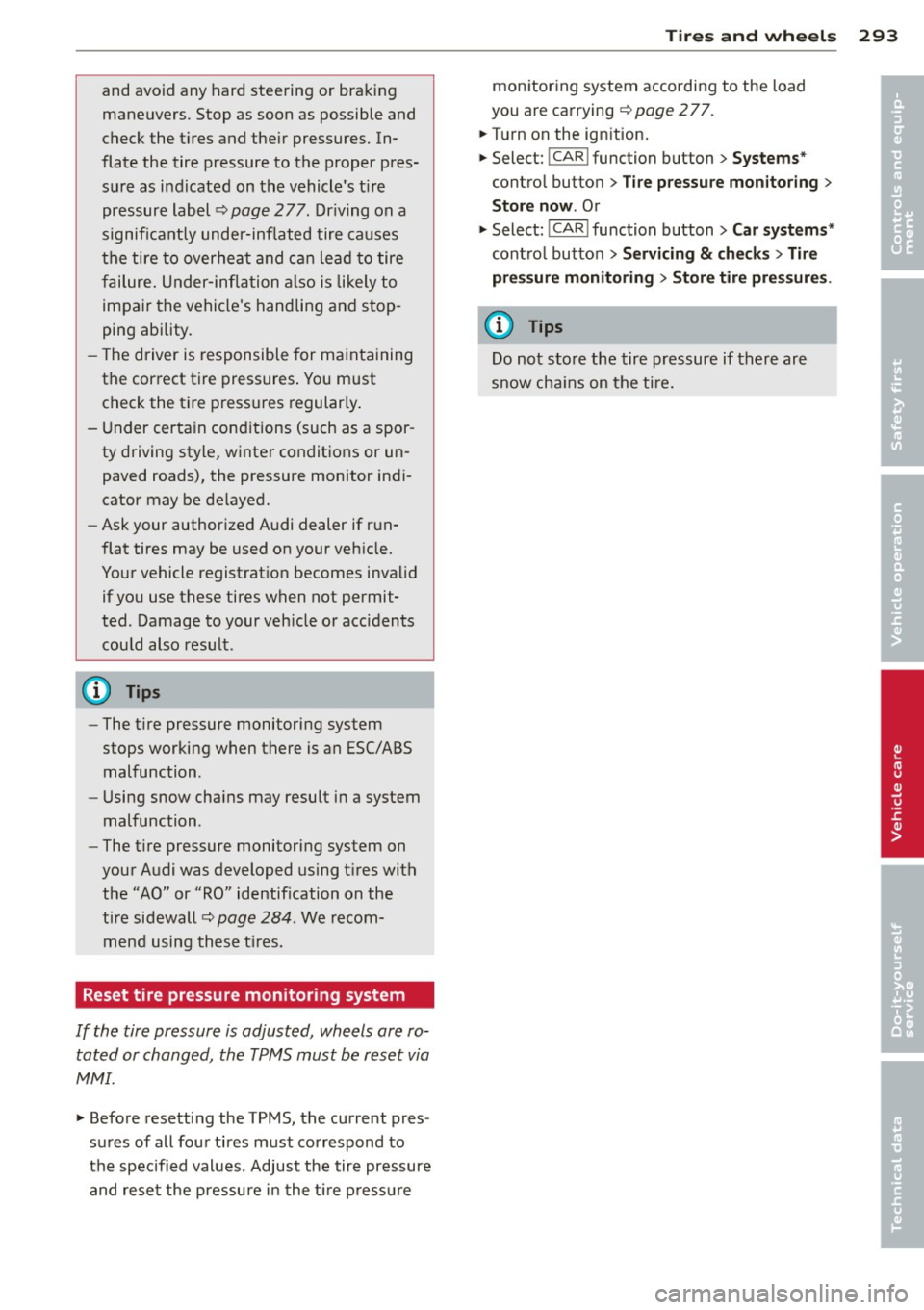
and avoid any hard steering or braking
maneuvers. Stop as soon as possible and
check the tires and their pressures. In·
flate the tire pressure to the proper pres
sure as indicated on the vehicle's tire
pressure label ¢
page 2 77. Driving on a
significantly under-inflated tire causes
the tire to overheat and can lead to tire
failure. Under-inflation also is likely to
impair the vehicle's handling and stop
ping ability.
- The driver is responsible for maintaining
the correct tire pressures. You must
check the tire pressures regularly.
- Under certain conditions (such as a spor
ty driving style, winter conditions or un
paved roads), the pressure monitor indi
cator may be delayed.
- Ask your authorized Audi dealer if run
flat tires may be used on your vehicle.
Your vehicle registration becomes invalid
if you use these tires when not permit
ted. Damage to your vehicle or accidents could also result.
@ Tips
- The tire pressure monitoring system
stops working when there is an ESC/ABS
malfunction.
- Using snow chains may result in a system
malfunction.
- The tire pressure monitoring system on
your Audi was developed using tires with
the "AO" or "RO" identification on the
tire sidewall¢
page 284. We recom
mend using these tires.
Reset tire pressure monitoring system
If the tire pressure is adjusted, wheels are ro tated or changed, the TPMS must be reset via
MMI.
.,. Before resetting the TPMS, the current pres
sures of all four tires must correspond to
the specified values. Adjust the tire pressure and reset the pressure in the tire pressure
Tires and wheels 293
monitoring system according to the load
you are carrying
¢ page 277.
.,. Turn on the ignition.
.,. Select:
!CAR I function button > Systems*
control button > Tire pressure monitoring >
Store now. Or
.,. Select:
!CAR I function button> Car systems*
control button > Servicing & checks > Tire
pressure monitoring
> Store tire pressures .
@ Tips
Do not store the tire pressure if there are
snow chains on the tire.
•
•